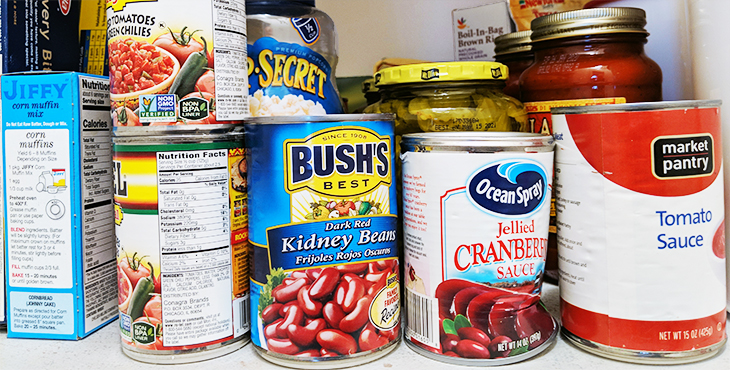With spring approaching, many of us will be tempted to “spring clean” our homes and toss what we no longer need. While we’re at it, let’s also organize our pantry.
What to toss:
- Expired foods. While canned and boxed goods have long expiration dates, they aren’t good indefinitely. Check those expiration dates! Try keeping items with the closest expiration dates in the front of your pantry, and the furthest expiration dates in the back. Toss rusted, dented, and bulging cans.
- Old spices. Do you have spices from years ago? For best taste and potency, using spices within a year of opening the bottle is best.
- High-sodium condiments. Trying to manage your blood pressure? Check the nutrition label for the percent Daily Value (%DV) for sodium; remember 5% or less per serving is low sodium.
- Items containing “partially hydrogenated oils” in the ingredient list. These are hidden trans fats that promote inflammation and unhealthy cholesterol levels. Common items containing these oils are shelf-stable coffee creamers, processed peanut butter, and processed foods like frosting and cake mixes.
What to keep and stock up on:
- Healthy grains. The USDA’s dietary guidelines encourage us to make half of our daily grain choices whole grains. Whole grains, due to their higher dietary fiber content, may help with feeling full after a meal or snack, regular bowel movements, and cholesterol levels. Examples of whole grains to keep on hand include brown or wild rice, whole wheat pasta or legume-based pastas (such as lentil or chickpea pastas), oatmeal, or whole grain low-sodium crackers. When choosing breakfast cereals, I recommend aiming for higher fiber and lower sugar content.
- Spices. Looking to reduce your sodium intake? There are plenty of delicious options that will help you avoid the salt shaker. Some of my favorites are garlic powder (not to be confused with garlic salt), dried parsley, basil, red pepper flakes, cinnamon, and a low-sodium grilling blend.
- Healthy oils for cooking. For heart health, use monounsaturated fats like olive, avocado, or sesame oil instead of solid fats. For low-calorie cooking, you may want to use a non-fat cooking spray.
- Another heart-healthy and high-fiber favorite, beans are inexpensive and delicious additions to soups, salads, and pasta dishes. Try draining out the liquid and rinsing well under water to remove up to 40% of the sodium listed on the label. Cooking dried beans is a cheaper and lower-sodium alternative.
- Canned fruits and vegetables. Look for “no salt added” or “low-sodium” canned vegetables and fruits canned in water or natural juice instead of heavy syrup.
- For quick and easy meals, having ready-to-eat protein sources on hand is a must. Try canned sardines (check labels for the lowest sodium options), wild salmon, tuna, or chicken.
- Healthy snacks. Try keeping these healthier snacks in stock: dark chocolate, unsalted or low-sodium nuts, baked potato chips, low-fat popcorn, or unsweetened applesauce.
Looking for some cooking inspiration using common pantry ingredients? Check out this VA Healthy Teaching Kitchen video, and these recipes on pages 28-30.
Michelle Hyman is an outpatient Registered Dietitian working primarily with the MOVE!® weight management program at the VA New York Harbor Healthcare system. In addition to face-to-face group and individual counseling, she enjoys using telephone and video technology to help Veterans reach their nutrition and health goals.
Topics in this story
More Stories
The Dayton VA Medical Center released its March 2025 Good News Report, spotlighting compassionate care, special recognitions, and life moments shared by Veterans and staff.
Each year, I return to honor my old corpsman's memory and reflect on serving together.
Veteran was trained to collaborate with fellow Airmen. Having his buddy’s six was important, and still is.







For better health remove free radical which removes Oxidative Stress